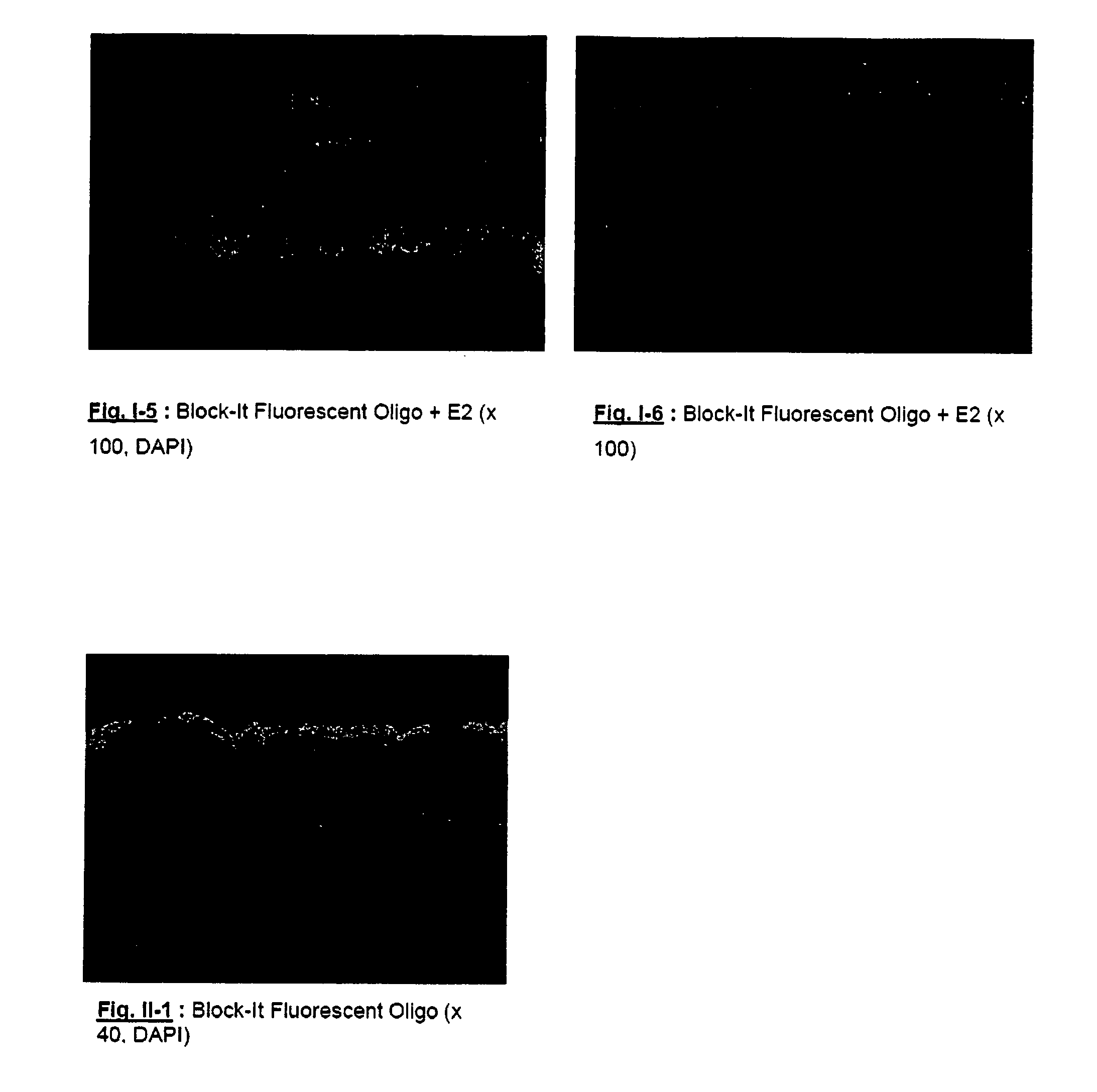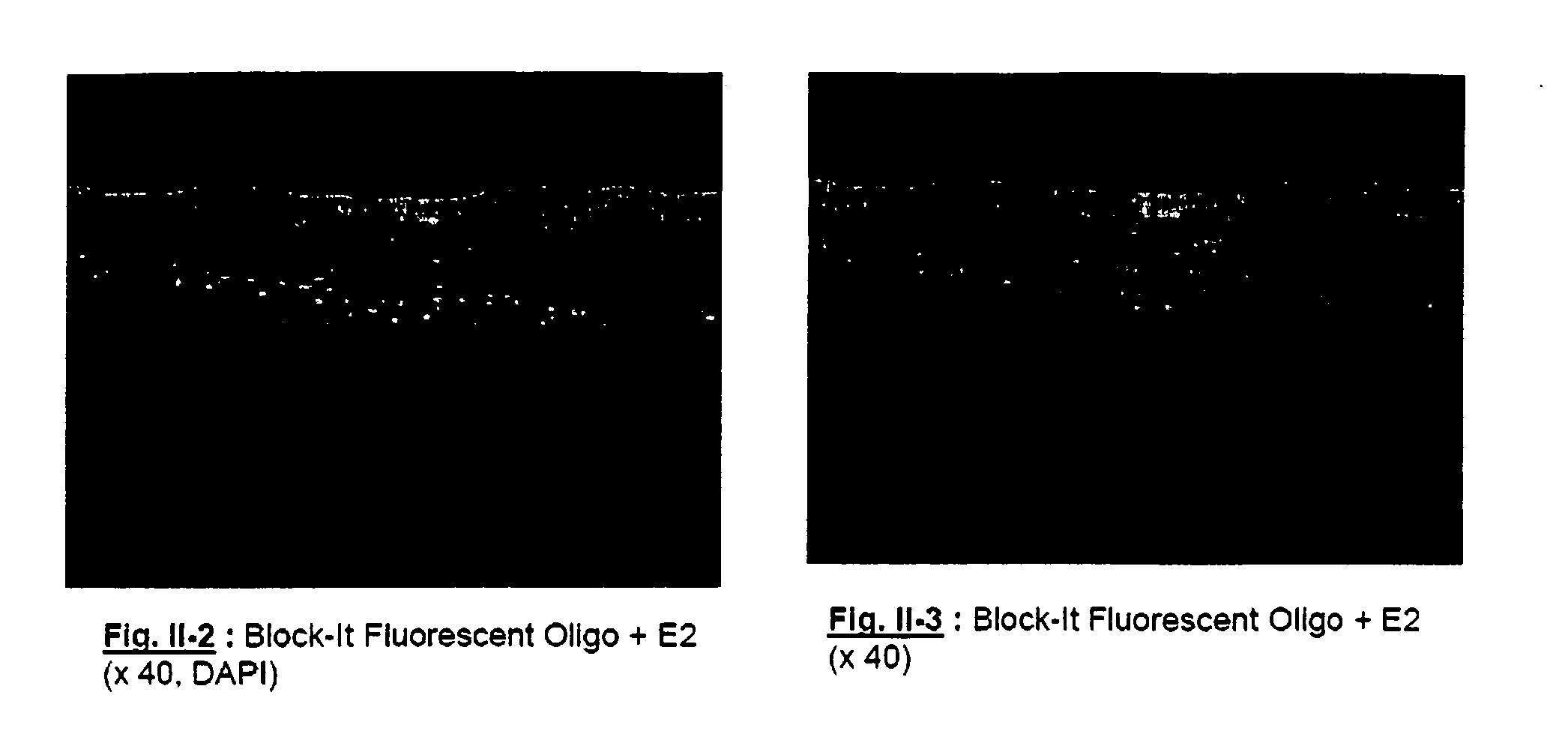Vectorization of dsRNA by cationic particles and topical use
a technology of cationic particles and rna oligonucleotides, which is applied in the field of vectorization of double stranded rna oligonucleotides by cationic particles, can solve the problems of difficult penetration, ineffective medicinal solution of surfactant micelles, and difficulty in penetration in stratum corneum,
- Summary
- Abstract
- Description
- Claims
- Application Information
AI Technical Summary
Problems solved by technology
Method used
Image
Examples
example 1
“fluid” Vesicles
[0290]
PEG 400 isostearate5.5%Behenyltriammonium chloride0.5%Distilled waterqsp 100
EXAMPLE 2
“Rigid” Vesicles
[0291]
Sorbitan palmitate2.75%Cholesterol2.75%Behenyltriammonium chloride 0.5%Distilled waterqsp 100
[0292] These examples of liposome suspensions are prepared by dialysis. The constituent lipids of the vesicles are solubilized in an aqueous solution of octyl β-glucoside. This solution is then dialyzed against water for 72 h.
[0293] The suspension of siRNA is added, making the vesicle concentration around 3% of lipid, this value being merely indicative.
[0294] Cationic Oleosomes
Oily phaseSucrose mono / di-stearate sold by Stearainerie Dubois0.45%Sorbitan (4 OE) stearate (Tween 61 Uniquema)0.30%Behenyltriammonium chloride0.21%Vitamin E acetate 0.5%Jojoba oil 0.5%Stearyl heptanoate 1%Volatile silicone oil SE 1%Vitamin F glyceride 0.5%Preservative0.02%BHT0.01%Aqueous phaseDistilled waterqsp 100Preservative 0.1%
[0295] This dispersion is prepared by high-pressure ...
example 2
Cell Targeting
[0303] Cell and tissue targeting was carried out in the reconstructed epidermis model developed by EPISKIN SNC. Two phases of growth kinetics of the model were chosen for topical application of the micelle / siRNA complex:
[0304] 1 application on day 6 of growth of the epidermis, corresponding to an epidermis at the beginning of stratification and keratinization.
[0305] 1 application on day 13 of growth of the epidermis, corresponding to a stratified and keratinized epidermis.
[0306] The siRNA chosen is Block-It Fluorescent Oligo (20 μM), such as described in the manual “Block-It Transfection Kit” (Catalog ref. No.: 13750-070, Invitrogen). It is a 25-nucleotide double stranded RNA coupled with fluorescein. The coded sequence has no homology with the human genome, and therefore makes it non-functional. This nucleotide was developed specifically for the study of cell targeting. When it is transfected, it is present in the cytoplasm and also penetrates into the cell nucleu...
example 3
Effect of a Formulation of Octyl Glucoside and CTAB in Different Concentrations on the Mortality of HaCaT Cells
[0318] The effect of formula E2: 50 mM micelles of octyl glucoside / CTAB in 5 / 1 molar ratio is achieved by incubation for 4 days according to the following protocol on HaCaT cells (500 μl of medium seeded with 40,000 cells per well, B-It: Block-It Fluorescent Oligo (Invitrogen).
[0319] 40,000 HaCaT cells per well are seeded in duplicate in a 24-well plate in 500 μl of complete DMEM+10% fetal calf serum.
[0320] 1 μl of Block-It Fluorescent Oligo (Invitrogen) is diluted in 1 to 15 μl of micellar solution E2, composed of 50 mM of micelles of octyl glucoside and CTAB in 5 / 1 molar ratio and added to the culture medium, bringing the final concentration of micellar solution to 0.1 to 1.5 mM.
[0321] The cells are then incubated for 4 days at 37° C., the medium for one sample of the duplicates being changed on day 1, after which they are photographed.
[0322] The results obtained are...
PUM
| Property | Measurement | Unit |
|---|---|---|
| zeta potential | aaaaa | aaaaa |
| zeta potential | aaaaa | aaaaa |
| size | aaaaa | aaaaa |
Abstract
Description
Claims
Application Information
 Login to View More
Login to View More - R&D
- Intellectual Property
- Life Sciences
- Materials
- Tech Scout
- Unparalleled Data Quality
- Higher Quality Content
- 60% Fewer Hallucinations
Browse by: Latest US Patents, China's latest patents, Technical Efficacy Thesaurus, Application Domain, Technology Topic, Popular Technical Reports.
© 2025 PatSnap. All rights reserved.Legal|Privacy policy|Modern Slavery Act Transparency Statement|Sitemap|About US| Contact US: help@patsnap.com



